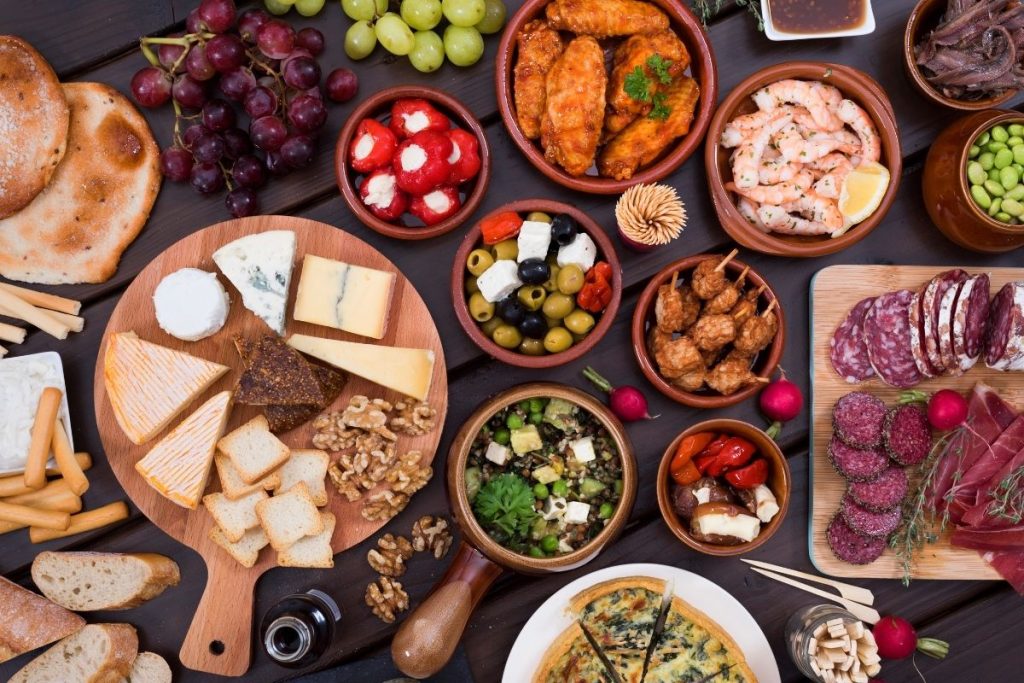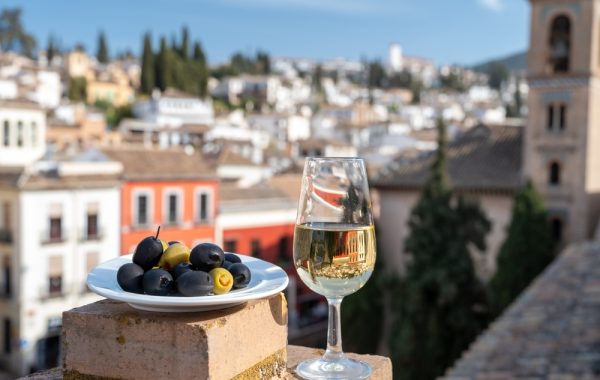Bring a taste of Spain’s culinary heritage home, with a curated collection of Spain’s most iconic tapas — featuring elegant vegetarian selections and timeless regional favorites for the discerning palate.
In Spain, tapas aren’t merely snacks — they’re a cultural ritual, a passport to the country’s soul plated in small, flavor-packed portions. These bites are how Spaniards linger over laughter, trade stories across crowded bar counters, and savor the art of unhurried living. Whether enjoyed in a bustling taberna tucked into a side street in Madrid or on a golden-lit terrace in Seville, tapas reflect not just the region’s ingredients, but its rhythms, its people, and its unmistakable zest for life.
While Spain is often celebrated for its jamón and seafood, its tapas culture tells a broader, more inclusive story — one where vegetables, olive oil, and sun-ripened produce take center stage. Across every region, vegetarian tapas are not just possible — they’re beloved, essential, and endlessly satisfying.
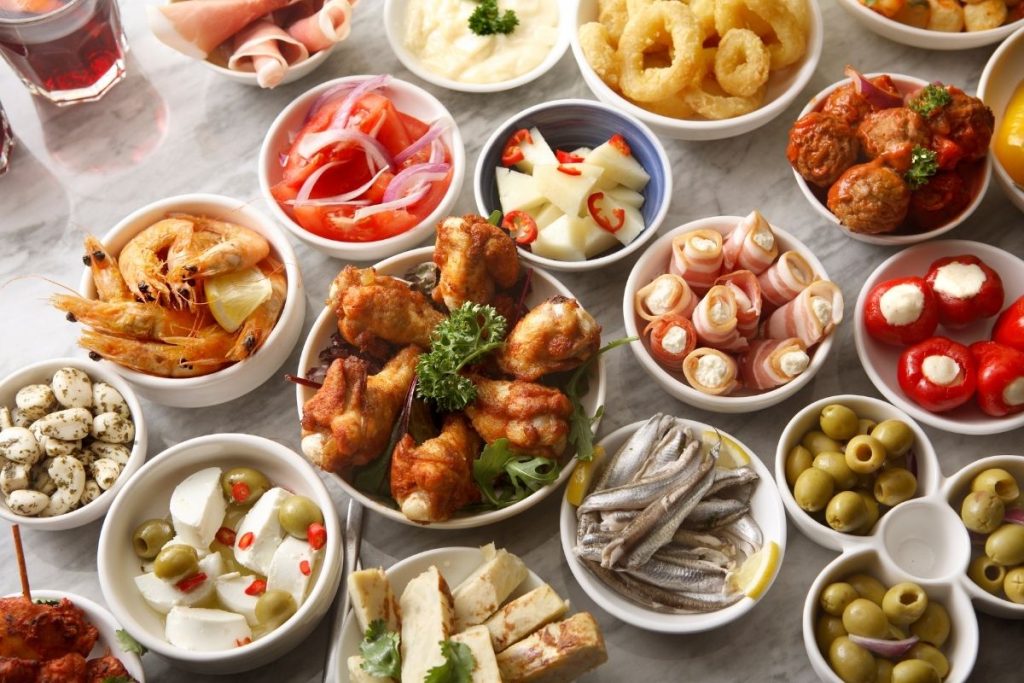
You’ll find classics like patatas bravas — crispy potatoes with a smoky, spicy kick — or creamy ensaladilla rusa, made in vegetarian variations just as indulgent. Garlic mushrooms and croquettes filled with wild mushrooms, spinach, or the nutty warmth of Idiazabal cheese (a specialty of the Basque Country and Navarre) are staples on many menus. In Galicia, Padrón peppers are flash-fried until blistered, while the Canary Islands offer papas arrugás — wrinkled potatoes paired with bold mojo sauces that bring the heat and herb in equal measure.
Come summer, cold soups take over. Gazpacho and its richer cousin Salmorejo — Andalusian classics — are tomato-based, refreshing, and surprisingly filling. And for something more substantial, dishes like vegetable paella, chickpea stew, migas de pastor (a humble breadcrumb dish), or tortilla de patatas deliver comfort without compromise. Regional specialties like tumbet in Mallorca (a rustic layering of potato, aubergine, and tomato) or escalivada in Catalonia (a smoky mix of roasted red pepper, aubergine, and onion) highlight just how deeply rooted plant-based dishes are in the Spanish kitchen.

What makes tapas truly special is their flexibility. Many classic tapas — such as Patatas Alioli, Coca de Trampó, Patatas Bravas — are naturally vegetarian, while others like Paella, Chistorra or Pulpo a la Gallega are rooted in local meats or seafood. And the best part? You don’t have to follow the script. Most Spanish kitchens are happy to tailor a dish to your preferences — swapping out ingredients, dialing up the heat, or preparing a vegetarian version on request. Allergies? Dietary quirks? Just ask. In Spain, tapas are as much about conversation as they are about cuisine — and the table is always set for you.
Let’s take a sun-dappled stroll through Spain’s most iconic tapas — bold, rustic, and endlessly shareable bites that reflect the country’s rich culinary soul.
Ready to bring Spain to your kitchen? Here are 9 classic tapas dishes, complete with easy-to-follow recipes.
GAZPACHO
This refreshing cold soup is a staple across several Spanish regions — from the sunbaked plains of Extremadura to the olive groves of Andalusia and the rustic heartlands of Castile-La Mancha. The Andalusian take is the most iconic, blending ripe tomatoes, garlic, and peppers into a silky, flavor-packed bowl that’s as nourishing as it is vibrant. A true celebration of the Mediterranean way of eating — light, fresh, and full of bold, honest ingredients — it’s the kind of dish that tastes like summer and feels like home.
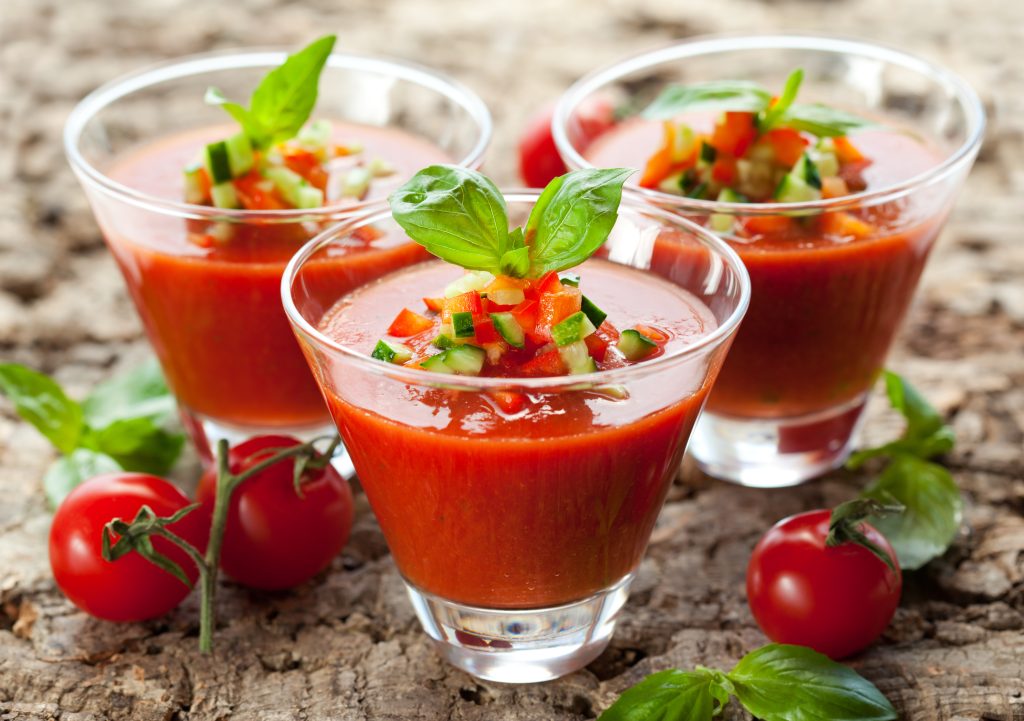
Recipe
Ingredients (Serves 4)
1 kg ripe tomato, 2 small green peppers, 2 garlic cloves, 100 g crusty country-style bread or wheat sourdough, 4 tablespoons extra virgin olive oil, 1 tablespoon sherry vinegar or white wine vinegar, salt, and water as needed. Optional toppings: boiled egg, diced bread, and seasonal vegetables.
Preparation
Start by soaking the bread in a bit of water until soft. In a blender, combine the soaked bread with chopped tomatoes, peppers, garlic, olive oil, vinegar, and salt. Add water gradually to adjust the texture — thicker for a hearty bowl, lighter for a refreshing sip. A blender makes the mix smooth and velvety, a modern twist on the traditional mortar and pestle method.
To Serve
Pour into small clay bowls or deep plates. Traditionally, it’s served with a side of finely chopped toppings — cucumber, tomato, onion, green pepper, toasted bread cubes, or hard-boiled egg — so each person can garnish to their liking. It’s as much about personal taste as it is about shared pleasure.
SALMOREJO
Salmorejo is a refreshing, tangy tomato soup that’s as cool to make as it is to eat — perfect for those sweltering Spanish afternoons. Think of Salmorejo as Gazpacho’s richer, creamier cousin: thicker in texture, silkier on the spoon, and typically topped with crumbled hard-boiled eggs and slivers of jamón. It’s simple, satisfying, and a sun-drenched staple of Andalusian summers.
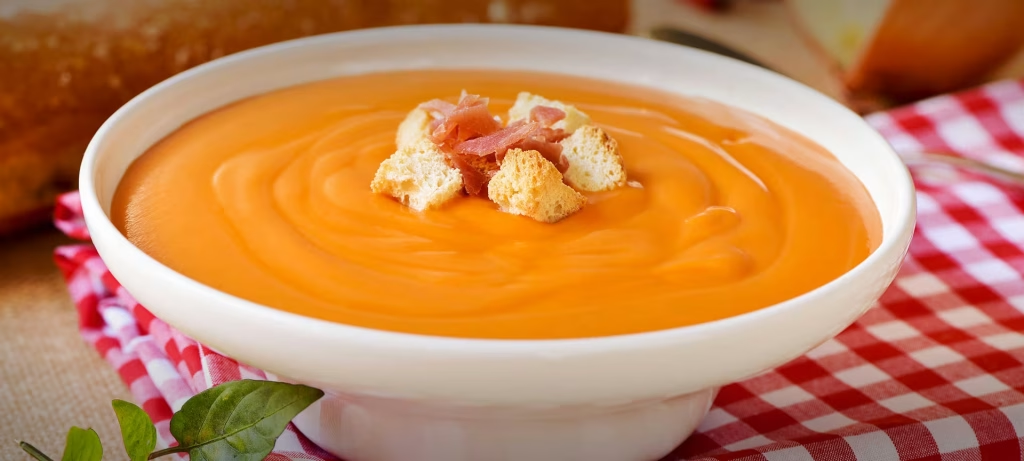
Recipe
Ingredients (Serves 4)
1 kg ripe tomato, 1 garlic clove, 200 g day-old bread, 100 g extra virgin olive oil, 10 g salt. Optional toppings: chopped hard-boiled egg and cured ham or smoked ham.
Preparation
Rinse and blend the tomatoes until smooth, then strain to remove skins and seeds. Soak the bread in a little water or directly in the tomato purée. Add the garlic, olive oil, and salt, then blend everything together until thick and creamy.
To Serve
Ladle into individual bowls and top with finely chopped egg and bits of ham, if using. Serve chilled for the perfect summer refresher.
PATATAS BRAVAS AND PATATAS ALIOLI
Few tapas capture Spain’s fiery spirit quite like patatas bravas — crispy golden potatoes tossed in a bold, smoky tomato sauce that lives up to its name (bravas means “fierce,” after all). The heat is subtle but satisfying, with just enough spice to wake up your palate without overwhelming it. Traditionally served with a swirl of garlicky alioli for contrast, each bite delivers a perfect trio of crunch, spice, and creamy depth. It’s rustic, rebellious, and endlessly addictive — the kind of dish that turns a casual drink into a full-blown feast.
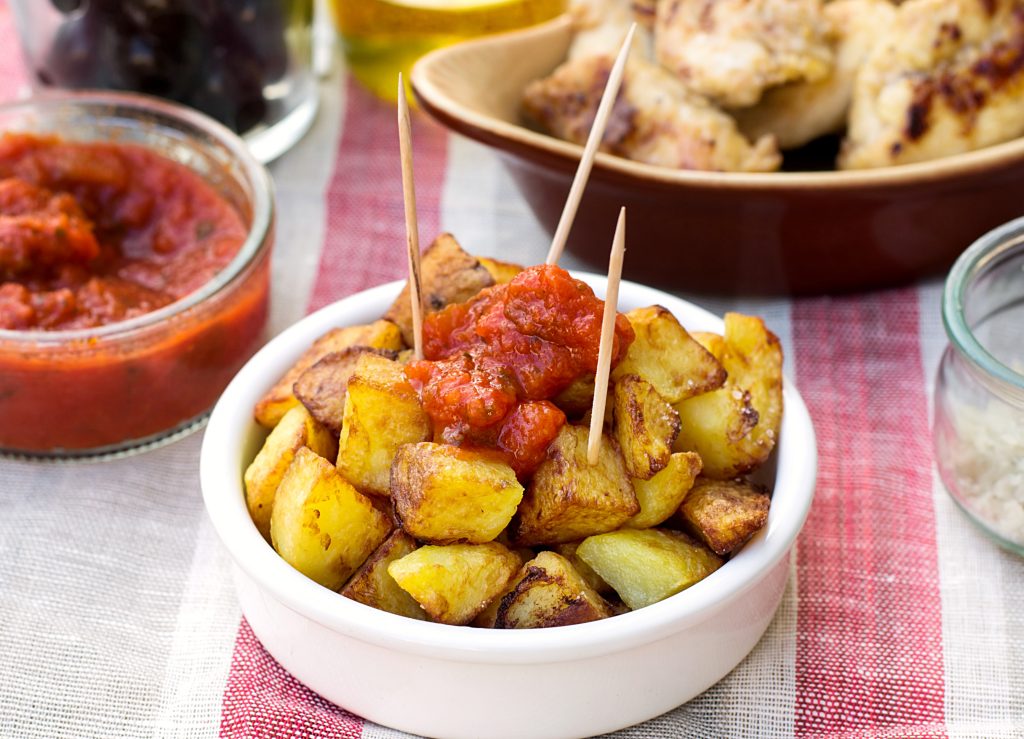
Recipe
Ingredients (Serves 4)
To make Patatas Bravas, you’ll need 1 kg of potatoes, 50 ml of light olive oil, 1 head of garlic with the skin on, 3 sprigs of fresh rosemary, a pinch of sweet paprika, sea salt to taste, and 1 tablespoon of chopped fresh parsley.
For the bravas sauce, gather 50 ml olive oil, 1 small finely chopped onion, 1 thinly sliced garlic clove, 1 bay leaf, a pinch of chili flakes, 1 teaspoon sweet paprika, 1 teaspoon sugar, a pinch of cumin, black pepper to taste, a splash of sherry vinegar or white wine vinegar, a pinch of dried oregano, 400 g of canned or fresh chopped tomatoes, 100 ml water, and salt to taste.
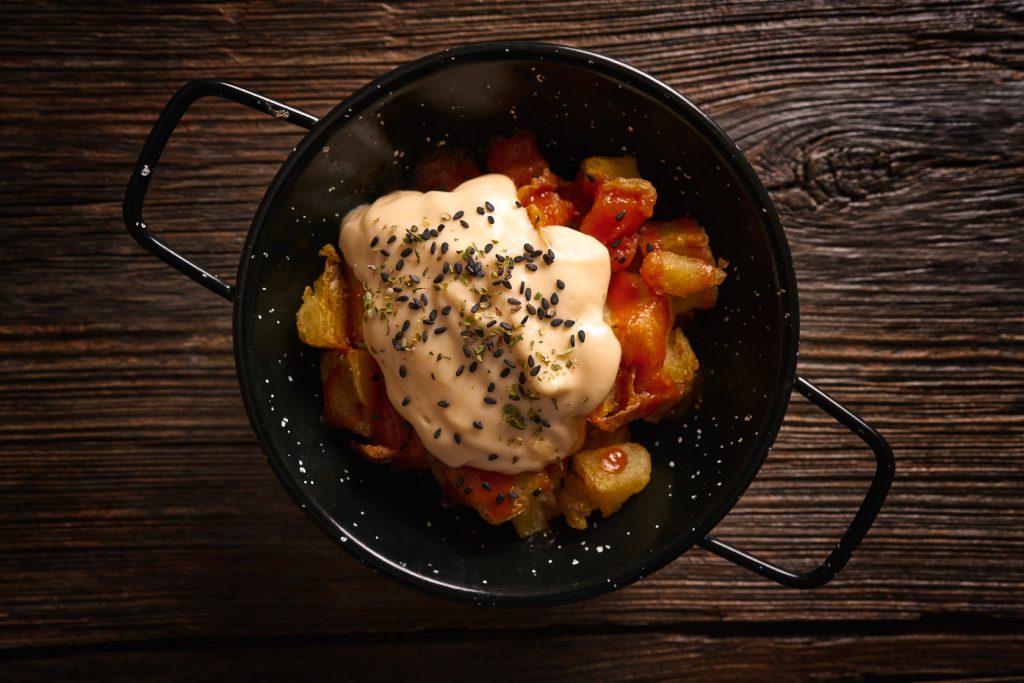
Preparation
To Prepare the Potatoes
Peel and cut the potatoes into bite-sized chunks. Soak them in cold water for 30 minutes to remove excess starch, then drain and pat dry. In a large pan, heat olive oil over medium heat with the garlic head and rosemary to infuse flavor. Fry the potatoes in batches until golden and crisp — about 15–20 minutes. Drain on paper towels, season with sea salt and a dusting of sweet paprika while still hot.
To Make the Sauce
Heat olive oil in a saucepan. Sauté the onion until soft and translucent. Add garlic and bay leaf, cooking for a couple more minutes. Stir in paprika, cumin, chili flakes, and oregano. Add tomatoes, water, sugar, and a splash of sherry vinegar. Let it simmer gently for 15–20 minutes until thickened. Remove the bay leaf, blend until smooth, and adjust seasoning as needed.
To Serve
Pile the crispy potatoes onto a platter, spoon over the warm bravas sauce, and finish with a sprinkle of fresh parsley. For an extra flourish, add a dollop of alioli (traditionally made with just garlic, olive oil, and a pinch of salt).
GILDA
Bold, briny, and undeniably Basque, Gilda is the pintxo that started it all. Found in nearly every bar across the Basque Country, this one-bite wonder delivers an electric mix of salty, pickled, and spicy flavors — a tribute to the region’s love of simple, punchy ingredients. Legend has it the combination was born in the 1940s at Casa Vallés in San Sebastián, where olives, anchovies, and pickled guindilla peppers were served separately until one imaginative regular threaded them all onto a toothpick. The name? A nod to the 1946 Rita Hayworth film Gilda — a femme fatale known for being green, salty, and a little bit hot.
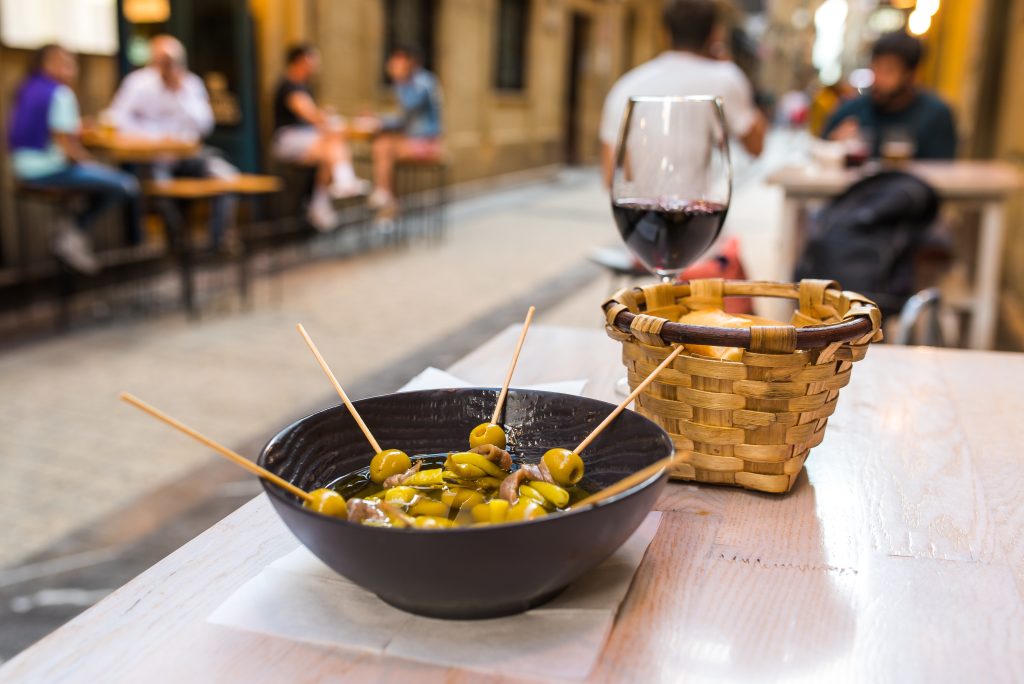
Recipe
Ingredients (Serves 4–6)
12 green olives (preferably manzanilla or a similar variety), 6 salted anchovy fillets halved lengthwise, 12 guindilla peppers with the tops removed or mild pickled jalapeños, and a generous drizzle of high-quality extra virgin olive oil. Wooden toothpicks or pintxo skewers are essential for assembling these bold little bites.
Preparation
Take a toothpick and skewer in the following order: one olive, one end of an anchovy fillet, two guindilla or jalapeño peppers, then loop the anchovy back and secure the other end, finishing with a second olive. Repeat for each skewer.
Place the finished gildas in a shallow dish and drizzle generously with extra virgin olive oil. Chill briefly before serving to let the flavours meld.
To Serve
Serve cold or at room temperature with a crisp glass of txakoli, cava, or your favourite light beer. Small in size but bold in flavour, Gilda is the ultimate Basque welcome shot—salty, spicy, and just enough to spark an appetite.
Pro Tip: For vegetarians, anchovies can be swapped out with colourful seasonal vegetables—think cherry tomatoes, cucumber slices, carrots, or shaved fennel. Roasted peppers also make a flavourful substitute, adding that same sweet-salty balance without the fish.
COCA DE TRAMPÓ
Often described as Mallorca’s answer to pizza, Coca de Trampó is a light, vibrant flatbread that celebrates the island’s sun-ripened produce. Topped with a simple mix of chopped tomatoes, green peppers, and onions — known locally as trampó — this dish bursts with Mediterranean flavor and freshness. Served at room temperature, it’s a rustic staple of Balearic kitchens, perfect for summer picnics, beachside snacks, or a casual bite with chilled white wine.

Recipe
Ingredients: (Serves 8)
2 cups hot water, 1 cup olive or sunflower oil, 5–10 g fresh yeast, flour (enough to form a soft dough), 3 ripe tomatoes, 2 green peppers, 1 onion, salt, black pepper, sweet paprika, and a drizzle of olive oil for topping.
Preparation
Start by dissolving the yeast in hot water, then stir in the oil. Gradually add flour, mixing until you get a smooth, workable dough. Lightly oil a baking tray and press the dough evenly across the base.
For the topping, finely chop the tomatoes, onion, and peppers, then toss them together in a bowl with a bit of olive oil, salt, black pepper, and a pinch of sweet paprika. Spread this fresh trampó mix generously over the dough.
Bake in a preheated oven at 200°C (top and bottom heat) for 30–40 minutes until the edges are golden and the topping is cooked through.
To Serve
Let it cool slightly before slicing into squares — ideal for sharing at picnics, parties, or a casual tapas spread.
CHISTORRA CON PATATAS (CHISTORRA SAUSAGE WITH POTATOES)
This fiery, flavor-packed sausage from northern Spain is a staple of Basque and Navarre cooking — and while it may live in the shadow of its cousin chorizo, chistorra more than holds its own. Slimmer and shorter in size, it’s typically made from finely ground pork or a pork-beef blend, seasoned generously with paprika, garlic, and salt for a bold, smoky character. Lightly cured or air-dried, chistorra sizzles beautifully on a grill or skillet, releasing rich aromas that make it impossible to ignore. Served with bread or tucked into a small roll, it’s a no-frills bite that delivers serious flavour.
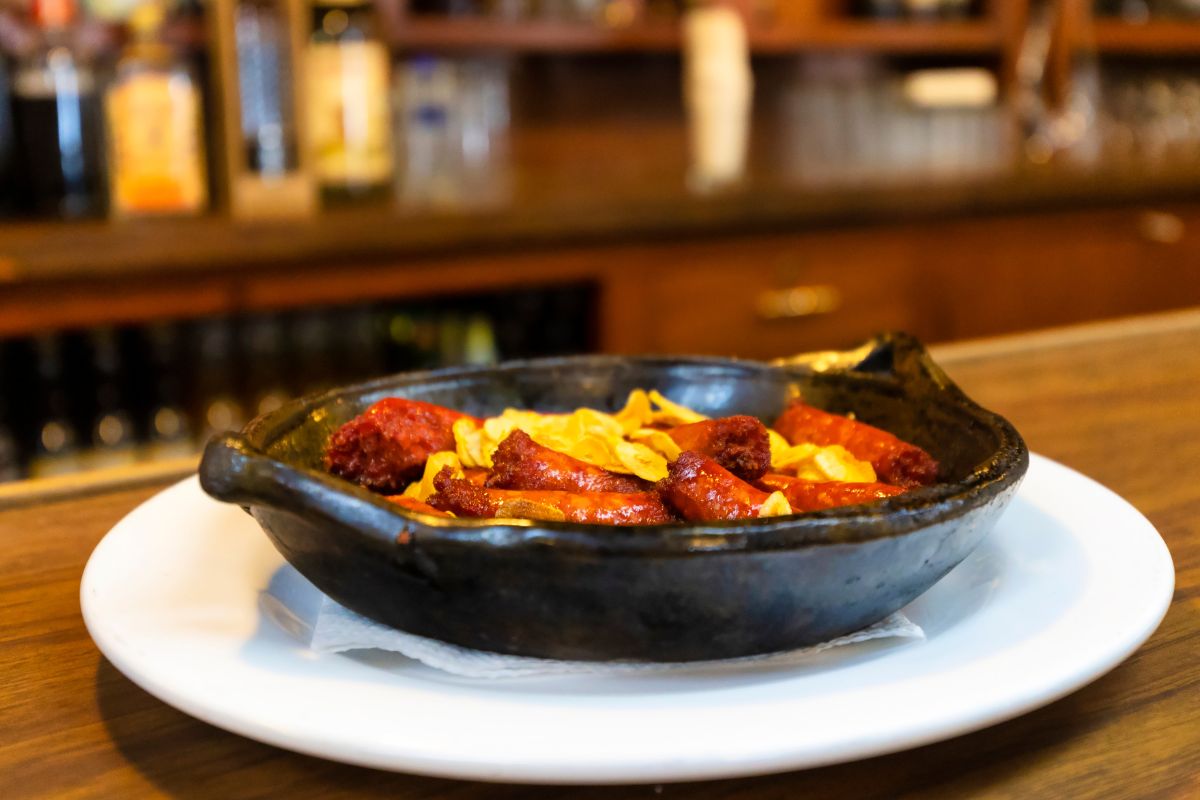
Recipe
Ingredients (Serves 2)
150 g chistorra sausage or Goan chorizo (cut into 4 cm pieces), 2 medium potatoes (cut into 2 cm cubes), 2 tablespoons extra virgin olive oil, and a pinch of salt.
Preparation
Heat half the olive oil in a pan over medium heat. Add the diced potatoes and a pinch of salt, cooking until they begin to soften. Add the chistorra and continue cooking, stirring occasionally, until the potatoes are golden and the sausage is browned and sizzling.
To Serve
Serve hot, ideally with crusty bread or as a base for other tapas combinations.
Pro Tip: For vegetarians or plant-based eaters, traditional meats can be easily substituted with high-quality vegan sausages—perfect for keeping the texture and flavour while staying meat-free.
PULPO A LA GALLEGA
This iconic dish from Galicia is a celebration of simplicity and flavor. Often served on a round wooden platter, Pulpo a la Gallega features tender boiled octopus, cut into bite-sized pieces, and finished with a sprinkle of sea salt, smoky paprika, and a generous drizzle of olive oil. It’s a staple at local festivals and family gatherings — no true Galician celebration feels complete without it. Rustic, rich, and deeply tied to the region’s coastal traditions, this dish is a true taste of northern Spain.
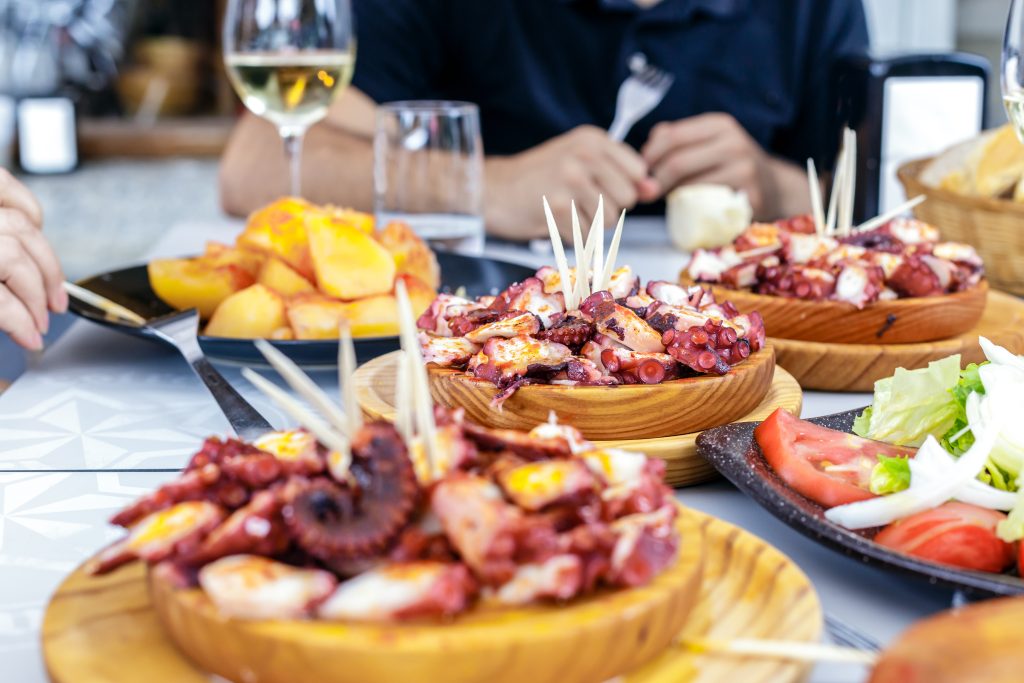
Recipe
Ingredients (Serves 4)
1 whole octopus (around 2 kg), 1 onion, 2 dl (200 ml) olive oil, 2 liters of water, 1 tablespoon sweet paprika, 1 tablespoon hot paprika, and coarse salt to taste.
Preparation
Begin by thoroughly cleaning the octopus — remove the beak, empty the head, and rinse well. Traditionally, the octopus is tenderized by beating it gently, though freezing beforehand can also help soften the texture. In a large pot, bring water to a boil with the onion. Using a skewer or tongs, dip the octopus into the boiling water three times to help the tentacles curl, then fully submerge it and cook until tender (cooking time varies depending on size and freshness). Once cooked, carefully lift the octopus out so the skin remains intact. Pat dry and cut into 2–3 cm pieces using kitchen scissors.
To Serve
Serve warm on a wooden plate, seasoned with coarse salt, a dusting of sweet and hot paprika, and a generous drizzle of olive oil.
Pro Tip: For vegetarians, you can recreate the texture and umami of octopus using shiitake mushrooms. Sear or grill them with a touch of smoked paprika and olive oil for a delicious, plant-based twist on this seafood classic.
PESCAÍTO FRITO
Crisp, golden, and straight from the coast, pescaíto frito is a beloved Andalusian specialty featuring small, fresh fish lightly coated and fried to perfection in olive oil. Often served in a paper cone and eaten by hand, it’s a street food favorite that captures the region’s seaside charm. Locals may also call it bienmesabe, and it’s typically seasoned with a touch of salt and regional spices — no sauces needed when the fish is this fresh and flavorful. Simple, satisfying, and best enjoyed with a cold drink by the sea.
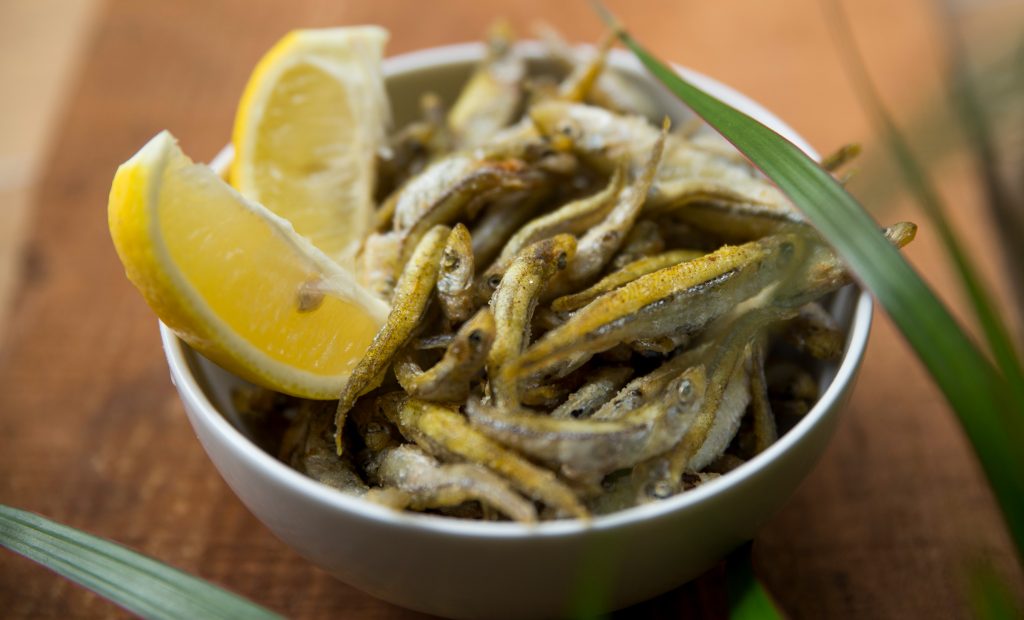
Recipe
Ingredients (Serves 4)
1 kg (approx. 2.2 lb) of your preferred fish — such as anchovies, squid, or small white fish, 1 cup flour, Olive oil (preferably Spanish), Sea salt to taste, 2 lemons, quartered (for serving).
Preparation
Clean the fish thoroughly based on the variety — gut and slice larger fish into smaller pieces, while small ones like anchovies can often be fried whole. Pat the fish dry using kitchen paper to remove any excess moisture. Lightly coat each piece in flour, shaking off any extra. Heat a generous amount of olive oil in a pan until it reaches around 180°C (356°F). Fry the fish in batches until golden and crisp. Once done, transfer to paper towels to drain, sprinkle with sea salt.
To Serve
Serve hot with lemon wedges. Simple, fast, and bursting with coastal flavor.
Pro Tip: For vegetarians, pescaíto frito can be reimagined by swapping the fish with paneer or tofu. Lightly coat in flour and fry until golden for a crisp, satisfying bite that still pairs perfectly with a squeeze of lemon.
PAELLA
Spain’s most iconic rice dish has countless variations, but purists will point to the traditional Valencian version as the original. This classic recipe features local short-grain rice, chicken, rabbit, and sometimes snails, simmered with a vibrant mix of green beans, broad beans, white beans (garrofó), tomato, garlic, paprika, olive oil, and a touch of saffron for its signature golden hue. While paella can now be found with seafood, vegetables, or even fusion twists, the soul of the dish lies in its regional roots and slow, open-fire cooking. For the full experience, enjoy it outdoors, ideally by the Mediterranean, where it was born — served straight from the pan and best shared.
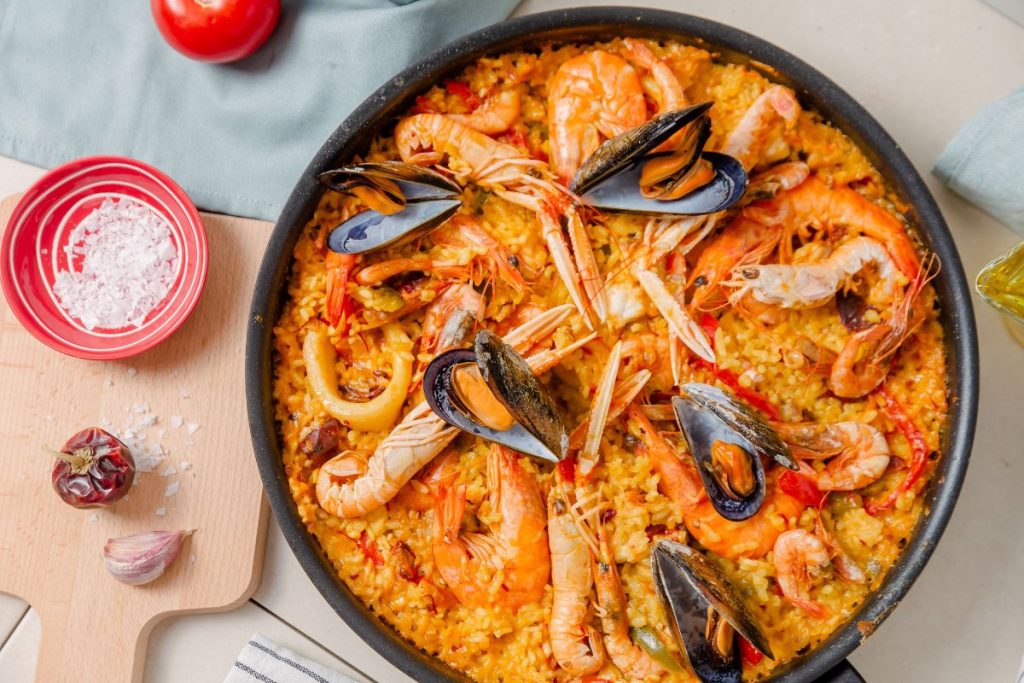
Paella Valenciana – Traditional Recipe
Ingredients (Serves 10)
1 kg short-grain rice, 2 kg chicken (cut into pieces), 1 kg rabbit (cut into pieces), 300 g chopped tomato, 500 g green beans, 250 g garrofó (Valencian white beans) or white kidney beans , 100 g peppers (optional), 2 dozen snails (optional), 300 ml olive oil, a few strands of saffron, 6 g sweet paprika, salt to taste, 3.5 liters of water. Optional: garlic and a sprig of rosemary.
Preparation
Heat olive oil in a wide, shallow paellera or a cast iron skillet, over medium-high heat. Once hot, add the chicken and rabbit and cook until browned all over. Stir in the chopped tomato (and peppers if using), and cook gently for about 7–8 minutes until the mixture softens and deepens in color. Season with salt and paprika, stirring carefully so the spices don’t burn.
Pour in enough water to cover everything and bring to a simmer. Allow the meat to cook until tender — around 30–35 minutes, especially if using free-range poultry or game. Add the green beans and garrofó or white kidney beans about 10 minutes before the meat is done, along with the snails if you’re including them. Top up with more hot water if needed and continue simmering for a few more minutes. Add the saffron and rosemary, adjust seasoning, and then evenly pour in the rice.
Let the rice cook on high heat for 5–6 minutes, then reduce the heat and simmer gently until the liquid is mostly absorbed and the rice is tender (about 15–20 minutes total). Remove from the heat and let the paella rest for 5 minutes before serving.
To Serve
Bring the pan straight to the table and serve warm, family-style, directly from the paellera. It’s a dish made for gathering — best enjoyed outdoors, with good company and even better wine.
Pro Tip: While Paella Valenciana is traditionally made with meat—and other regional versions often include seafood—you can easily swap in seasonal vegetables for a delicious vegetarian take on this Spanish classic.
Whether you lean vegetarian or crave the sea’s bounty, Spain’s tapas culture welcomes you with open arms, a glass of vermouth, and always, a little extra salsa if you ask.
Insider Tips for Eating Your Way Through Spain

- If you like your food with a bit more kick, don’t be afraid to ask for extra salsa picante—many spots will happily bring some on the side to spice things up to your liking.
- And when it comes to portions, a little local lingo goes a long way: many beloved dishes like paella or migas can be ordered as a tapa—a small serving meant to accompany your drink—or as a ración, a larger plate designed for sharing. Knowing the difference means you can sample more, mix and match, and eat like you’ve done this before.
This article is published in collaboration with Tourism Office of Spain (Turespaña), Mumbai. For more information, follow Turespaña on Instagram, Facebook, X and YouTube
For latest travel news and updates, food and drink journeys, restaurant features, and more, like us on Facebook or follow us on Instagram. Read more on Travel and Food Network


